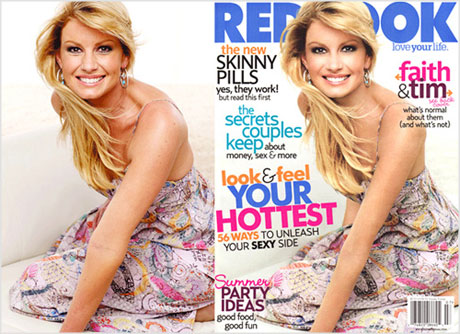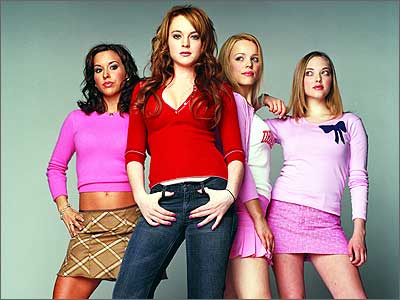“What
a Girl Wants”; an insight into how the media warps and influences
the way society perceives young women
In society today, teenage girls are
represented in a generalized and superficial way; the media shows
them in a light that supports the modern idealistic version of female
‘ perfection’ . This definition of perfection has been
constructed through years of the media portraying women to look and
act a certain way, which has spiraled into unrealistic expectations
and pressure from society that real women today have to strive
to live up to.
Don't you think it’s crazy how warped
and fake the images of females that the media thrusts upon us are?
Virtually every photo in magazines and in billboards are now
being virtually altered to some extent, to portray the women in the
photos as utterly flawless, aligning with societies idea of ' the
perfect female': “the feminine ideal is tanned, healthy
slenderness, with no unsightly bumps, bulges or cellulite, and bodily
and facial perfection that results from hours of labour: exercise,
makeup and hair care” - Coward, 1985. Airbrushing creates cover
girls without curves, models without pores, hips narrow as thighs and
waists sliced down to the size of a neck.
When did this become
the idea of perfection? Originally, the most beautiful woman of all
time was said to be the Greek goddess Aphrodite, who every man fell
in love with at first sight because she was so stunning. But hang on,
she wasn't a size 0... Ancient paintings reveal she was extremely
curvy with wide hips and thighs that (gasp!) TOUCHED IN THE MIDDLE.
She was natural. No photoshopping there! Her image of beauty was
attainable for the
average woman of our time now! And not just through starving yourself
and masses of plastic surgery.
 Perhaps
this is why the standard of perfection has been changed throughout
the years, as a way for society to prevent every woman from being
able to be viewed as the epitome of perfection so that beauty becomes
more 'special' and selective. When really, shouldn't it be the other
way round?
Perhaps
this is why the standard of perfection has been changed throughout
the years, as a way for society to prevent every woman from being
able to be viewed as the epitome of perfection so that beauty becomes
more 'special' and selective. When really, shouldn't it be the other
way round?
Not only does the
media force these altered images of ‘ perfect’ women in our faces
day after day via advertisements, magazines, billboards and
television, but teenage girls are also told that their role models
should only be women of the utmost physical perfection by putting
them up on a pedestal. The media does this by putting a spotlight on
basically only physically
attractive young women's accomplishments; barely any giving coverage
of the successes of less attractive girls. Take red carpet coverage
for example; when the media covers any awards shows, they scrutinize
the appearance of every recipient (usually becoming especially harsh
when it comes to young females) that walks down the red carpet,
declaring their own unofficial awards of the evening (“ Hits and
Misses” “ Best and Worst Looks of the night” - E!News) based
on who looks the best and worst. Not only does this undermine the
actual point of the
ceremony, which is to reward talent, but it also sending a message to
the world that the most successful people, the people we should look
up to and strive to be,
are the ones who look and dress the best. The media represents young
women to be 100% about looks; the more perfect, the more physically
attractive, the better. Flawless = a hit. Anything but superficial
perfection = one big miss.
“Becoming
the new feminine ideal requires just the right combination of
insecurity, exercise, bulimia and surgery.” - G.B Trudeau
The way teenage
girls are represented by the media socially is also appalling.
The media supports social stereotypes, mostly portraying girls to fit
very neatly into a certain typical social group eg: ' the popular
girls' ' the emo girls' ' the nerdy girls'. This is evident in
almost all tv shows and movies that revolve around High School drama,
so a perfect example is the 2004 film “ Mean Girls” , directed by
Mark Waters. In the movie, there is a scene where Janice is
describing the social classing of the High School to the new girl,
Cady Heron.
The director portrays each stereotypical persona of the groups very clearly through their actions and the costuming choices. For example, as Janice says “Desperate Wannabees” the obviously, ‘unpopular’ group is shown onscreen, all looking really delighted over the burgers they are eating. They all are wearing unfashionable, unflattering clothes, are relatively unattractive, overweight, wither greasy, unstyled hair and what looks like no makeup at all. As a contrast, the Plastics (aka the three popular girls) , are all stunningly beautiful, sitting there nibbling at their salads, sipping on diet coke with snobby expressions. Each one is costumed extremely similarly to be in stylish, semi-revealing clothes with impeccable hair and makeup. And of course, Regina George, the one seated in the middle of the other two popular girls (which gives the auidence the impression that she is the dominant ' leader') is blonde, which supports the stereotype of popular girls being skinny, pretty and blonde. In a subtle way, the director also gives the impression that the popular girls ('Plastics') are superior to the rest of the school via camera angling; as the camera pans around the cafetaria as Janice's voiceover describes the social groups, the camera is angled slightly higher than everyone. Then, when it comes to the Plastics, the camera is angled slightly lower than them, creating the impression before we even hear them speak, that we are inferior, looking up to them. In doing that, the director has already begun to show the teenage girls watching the movie that pretty, skinny blonde girls will always be more popular than the less-skinny, less well dressed girls... and that the popular ones are more superior and should be looked up to.
An equally terrible as it is increasingly common way that young and teenage women are represented in the media today is as expendable, brainless objects that come in bulk for men to watch, enjoy and use to their own advantage. This is a big statement to make, but it is true, as one will realise simply by turning on MTV and watching a couple of hip-hop or rap music videos with a male artist. In almost every single one, the video will have an extremely complicated concept; the artist...surrounded by 10 or more model-like, barely out of school girls, who (no matter how unattractive he is) ADORE him, and cannot control themselves from touching him and dance/grinding against him or for him as he sings. A main culprit of overusing this video-concept is the singer/rapper 'Flo-Rida' and his latest music video for his song ' Whistle' is no exception. The main idea of the video is as follows: Flo-Rida sits on the beach, on a nice white double bed, drinking, watching 20 or so young women (median age 19, despite the fact that Flo himself is 32) roll around in the sand and surf in bikinis, splashing themselves suggestively with water while making eyes at Flo. Later, Flo-Rida goes and joins them in the water, kindly spreading his attention amongst the young ladies, singing to one affectionately (“Can you blow my whistle baby, whistle baby?”), then, just as you think their relationship is becoming committed, he moves onto another girl, writhing in the sand, and sings to her too.
The fact that every one of the girls is similar looking (slim, toned, athletic, tanned and all in skimpy bikinis) and there are so many of them, represents young women/ teenage girls to be (or than they should be all the same), and the way that Flo Rida moves from one to another with ease, supports the idea that they are not unique and individual, but expendable.
So...
what's the consequence of all this?
The website, 4Beauty talked to 517
women in the UK (aged 16+) to find out what matters to you. One of
the finds was that more than half (53%) often worry that they look
dumpy/fat/chubby. When women dislike their bodies and focus more on
their physical imperfections than on their happiness and health,
their body dissatisfaction can lead to eating disorders, body
dysmorphia, harmful over-exercising or depression. The fact that the
media constantly portrays an image of how teenage girls SHOULD look,
through showing digitally altered images of ' perfect' girls on
magazine covers, excessively contributes to the dangerously low
self-esteem that is occurring in young girls today regarding how they
look.
So if the result of this representation
is so harmful to real young women, why do we continue to get these
fake images of unattainable perfection forced down our throats day
after day?
The most prominent reason: money. If
you look at the images of these photoshopped women, all of them are
trying to sell us something, or are a celebrity on a magazine cover
who has most likely signed an endorsement deal and wants their face
out in the public. Because of this, the women need to be represented
as appearing flawless is so that the company will sell more of their
product.
Say for example, the photoshopped image
was a model on a billboard for an ad campaign for underwear. By
showing the lingerie on a flawless model, the company sending the
subliminal message to their potential customers that in wearing their
underwear, they will become equally as sexy as the models. This ploy
works initially, but the negative effect that this representation
has, is that once young women realise that this isn't the magic way
to become as flawless as the model, it can cause even bigger
consequences than them just not being happy with the lingerie they've
purchased; it can cause them to be unhappy with themselves.
Even worse than this, the fact that
these false representations of young women are everywhere we look, it
means that the rest of society sees them too, so others begin to have
unrealistic expectations on young women too. This particularly seems
to occur with young males, who see models in magazines and raise
their standards to wanting a relationship with a girl who looks as
flawless as them. Not ok.
This kind of representation of girls
shown in Mean Girls can be blamed for the social attitude of
teenage girls themselves. When they see this kind of portrayal,
supporting generalized stereotyping based on outer appearance, it is
easier for them to stereotype other girls like this as well; judging
them and classifying them into certain groups just because they
display some qualities of the stereotype, just as girls do in the
movie. But the thing is, the way the stereotyped girls in the film
are represented is not realistic at all! It portrays teenage girls to
fall neatly into one social category, displaying all traits of this
stereotype very clearly.... when in reality, even if they are
stereotyped into a certain group, girls still can display certain
qualities that other group members may not possess. This is what
makes them an individual!
So if this is the case, why are girls
represented this way in so many movies and tv shows today?
Simple. BECAUSE IT IS FOR
ENTERTAINMENT PURPOSES. Its fiction! It creates a dramatic setting
with entertaining characters; by putting teenage girls into certain
boxes and stereotypes in the way they dress, talk and act, they are
easier to identify as being that stereotype, eg a ‘popular’ or a
‘nerd’.
Unfortunately, young girls viewing tend
to take it as gospel on how they too should judge their peers. The
effect of this is serious, creating harsh judgment, stereotyping and
bitchiness in high schools amongst teenage girls. Those who get the
short end of the straw (eg: are classified as a 'nerd' on their
first day of High School because they wear the wrong shoes) can be
victimized badly by this and have to deal with it for years.
Once girls are identified as a certain
stereotype, it makes it hard for them to break out of it and show
individuality and embrace their own uniqueness.
When women are objectified in the
media, shown to be expendable, easy to come by in bulk and basically
fair-weather sextoys of men (exhibit A: basically every Flo Rida
music video ever created), it changes societies perception of young
women, and even girls' view of themselves! This representation
diminishes any idea that we're unique, special and deserve respect!
Because we are! When young girls see young women dancing around a
rapper sexually in a bikini, looking like they're having the time of
their lives while they're being total skanks, it causes them to think
that maybe that's what they should be doing; this can lead to
them acting like this as they grow up and use these ' successful'
types of women they see in all these videos as their role models. And
skanky role models create a skanky generation of girls that's going
to become more and more evident in our society if these sort of
portrayals continue.
Its basically an unending circle of
skankiness.
The other negative part of this
representation is the man/woman ratios. As mentioned before, a common
theme in these kind of portrayals is that the women seem to come in
bulk and their main purpose is to seem really into the man, wanting
to please him..while the man stands there rapping and looking like
this kind of thing happens to him everyday. This causes MEN who see
this to have these expectations upon women too! They lose respect for
girls and wonder why girls expect romance from them when “hey,
according to that music video I just saw, that girl and all her
friends should be grinding me in bikinis!”
Obviously THIS COMPLETELY GOES AGAINST
THE GENDER EQUALITY THAT HAS BEEN WORKED SO HARD FOR IN OUR SOCIETY!
The concept that women are equal to men has been strived for for so
many years and then when we finally achieve it, we get a wave of
this! Large volumes of women being shown to be at the beck and call
of men to be their pretty little dancers!
So why is it happening? Personally, I
think it is the entertainment industry wanting to be progressively
outrageous each time they release music videos, pushing the
boundaries of what is socially acceptable so they portray young women
and teenage girls like this to shock people. But what happens when
the shock wears off and it becomes the norm for women to be
objectified by men? We'll be right back in the society we were in 200
years ago, when women had no rights whatsoever, and all that has been
worked for will be for nothing.
The way teenage girls are being
represented in the media today is shocking to say the least. If
something isn't changed, we could be looking at our entire female
generation being a mess of eating disorders, low self-esteem,
stereotypes and objectification under the thumb of men.
Realistically, no matter how many times
we tell the media the way that they portray young women is wrong and
needs to be stopped, they won't listen. The media is centred around
money and entertainment; they don't see it as their problem that
hundreds of young girls go home and skip dinner, make themselves sick
or cry themselves to sleep because they don't look anything like a
photoshopped model on the cover of their favourite magazine.
Since they are not going to change, the
change needs to come from us as
a society!
If we
change our mindset, then no matter how the media represents us to be,
it won't have any effect!
The
key is to remember one thing: that every girl and woman is beautiful,
unique and perfect in their own way. And every single one of us
deserves respect from everyone.
Once
we as a society change the way we view teenage girls and don't allow
what we see in the media to control these views, we'll find that we
are no longer influenced by the media...
The media will be influenced by us.

